You may know that venting your house is essential, but did you know that venting your shed can be useful, too. There are items that you store in there that will benefit from a controlled temperature environment and airflow. The structure itself also benefits from these two things.
Sheds are not considered a part of the ventilation standards in the building code as they are considered uninhabited spaces. However, renovating the space into something more or using it for gardening or hobbies can make ventilation necessary. This is especially important for an insulated shed as it will be more isolated, so I have complied 7 methods for you to consider.

Effective shed ventilation comes from combining the following vent options: soffit, ridge, gable, cupola, mushroom, venting skylights, and exhaust fans. Shed ventilation (including type and the number and location of points) is important for health and creating comfortable, useful spaces.
7 Ways to Vent an Insulated Shed
1. Soffit Vents
Soffit vents are installed under a roof’s overhang, or eaves (difference between soffit and eaves). You can install multiple vents that allow air to enter and circulate a room, but these work better in tandem with another ventilation device, like a ridge vent.
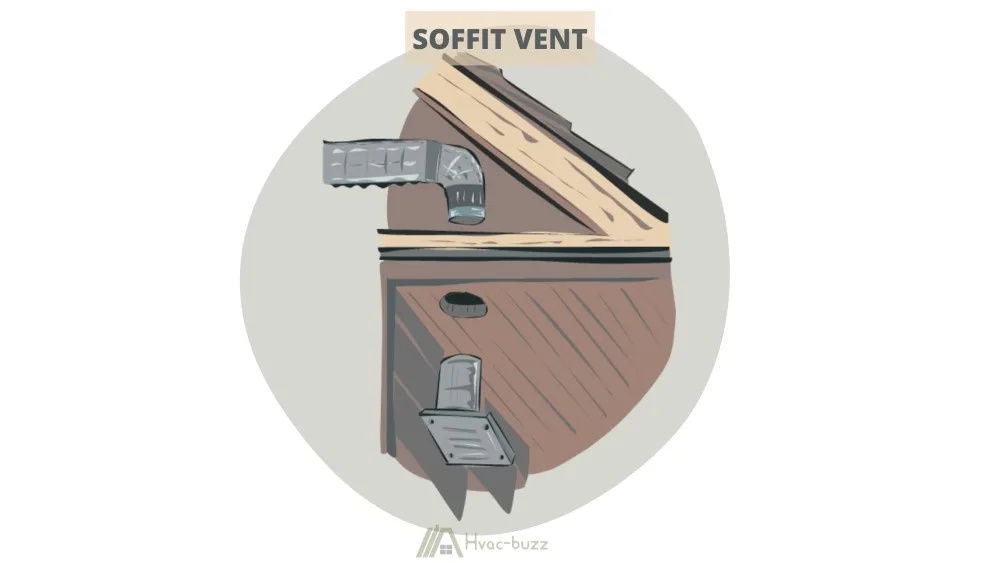
Pros
- Unintrusive.
- Easy to run multiple vents along the eaves.
- Individual or continuous (clip together nicely) option.
- Help prevent mold and mildew.
- Increase efficiency of ridge, gable, and roof vents.
Cons
- Optimal ventilation from a soffit vent requires other devices, such as a box fan or ridge vents.
- Prone to backdraft issues.
Average Cost and Installation
$300-$650 should be included in your budget for soffit vents. This price includes labor as well as materials, meaning it might cost you less if you install the vents yourself.
Installing soffit vents yourself is simple enough as long as you do your research on the process.
2. Ridge Vents
Ridge vents are installed at the top point on a sloped roof and are a great option for your shed. The hot air rises towards the vents and creates a vacuum-like effect that circulates the air. They can be run along the length of the roof peak to provide sufficient and well-distributed ventilation to the entire shed. Ridge vents are quite common in houses for ventilating attics, so you have probably seen them before.
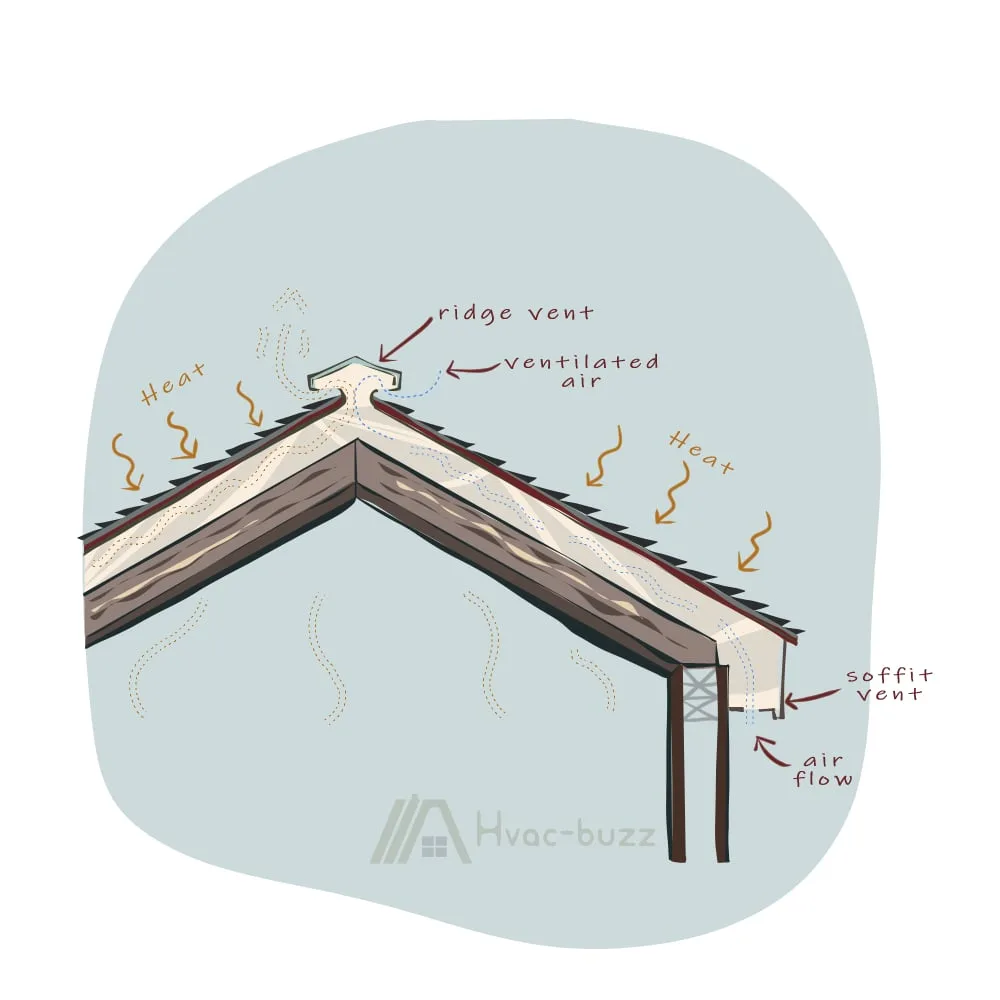
Pros
- Good for taller, larger sheds.
- Can install as many as the roof will allow.
- Inconspicuous.
- Help prevent mold and mildew.
Cons
- Requires sloped roof.
- Risk of leaking in heavy rains.
- Depends on passive airflow.
- Requires lower vents, like soffit vents, to make them viable.
For a more comprehensive list, albeit one aimed more at ridge vents in houses, you can check out Ridge Vent Pros and Cons.
Average Cost and Installation
You can pay anywhere from $350-$600 for installing ridge vents, but it should be cheaper (around $350) to do it yourself. You will likely need to factor in the cost of lower vents to guarantee proper ventilation, though.
Ridge vents are easy to install yourself; however, incorrectly installed, they will be ineffective as airflow will be inhibited, and snow and rain will be caught in the vent.
3. Gable Vents
Gable vents sit on the side of a roof at the point. They are good for passively exhausting air and pulling in air, but won’t work effectively without wind. Air needs to be moving perpendicular to the vents to push into the vents and push the stale, humid air out of the other side by creating negative pressure.
Pros
- Designed to allow airflow in and out.
- Help prevent mold and mildew.
- When paired with soffit vents, they can provide continuous ventilation.
- Low maintenance.
Cons
- Not suitable for all roof designs.
- Comparatively not the best type of vent on its own.
- Difficult to install.
- Don’t pair well with ridge vents.
Average Cost and Installation
The gable vent can cost you about $50-$300 depending on the vent’s style, size, and material.
When installing gable vents, it is important to use precision. The vent must be aligned correctly to achieve the most effective airflow, and an improper installation is unsightly.
4. Cupolas
Cupolas tower structures (complete with walls and a roof) sit on the ridge of your roof. They can have windows or vents on the sides to provide ventilation and natural light.
They allow gases to escape the structure and let in fresh air while protecting the openings from the weather with downward-pointing louvers. Air gets pushed up under the slats and circulates down through the shed.
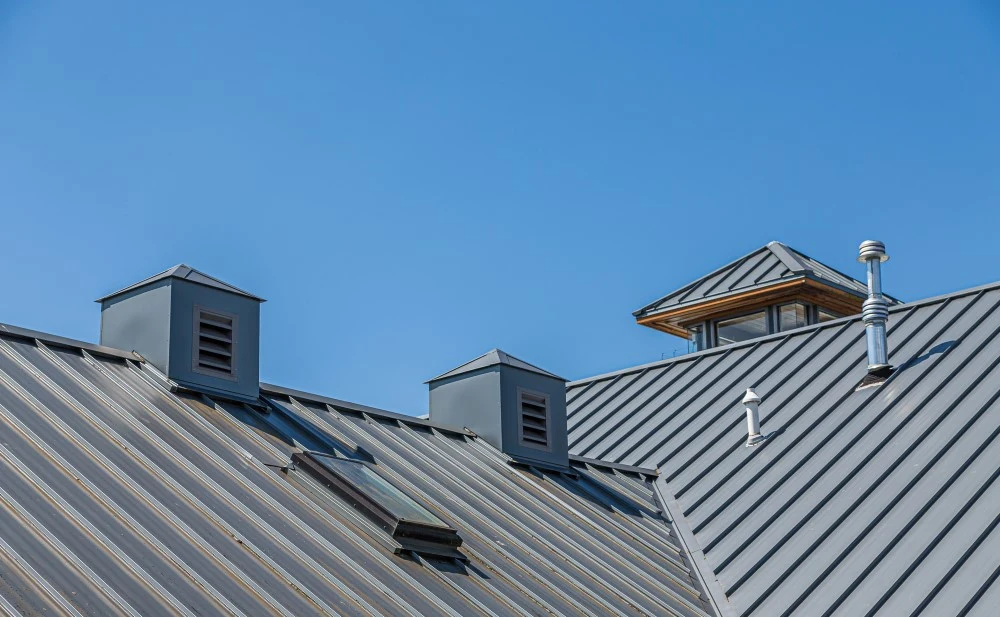
Pros
- Slats prevent leaking.
- Windowed cupolas provide light.
- Comes in a variety of designs.
- Helps prevent mold and mildew.
- Very style-specific.
Cons
- Requires cutting out a section of roof.
- Large, bulky, and conspicuous.
- Might have to choose between windows or vents.
- Very style-specific.
Average Cost and Installation
$180-$960 is the cost ballpark for installing cupolas. This is quite the range and depends on size, design, and materials.
The installation is complicated by needing to cut a hole into the roof and then seal it correctly to prevent leaking.
5. Venting Skylight
Venting skylights can open, unlike fixed skylights, which means that they can provide ventilation and light to the shed.
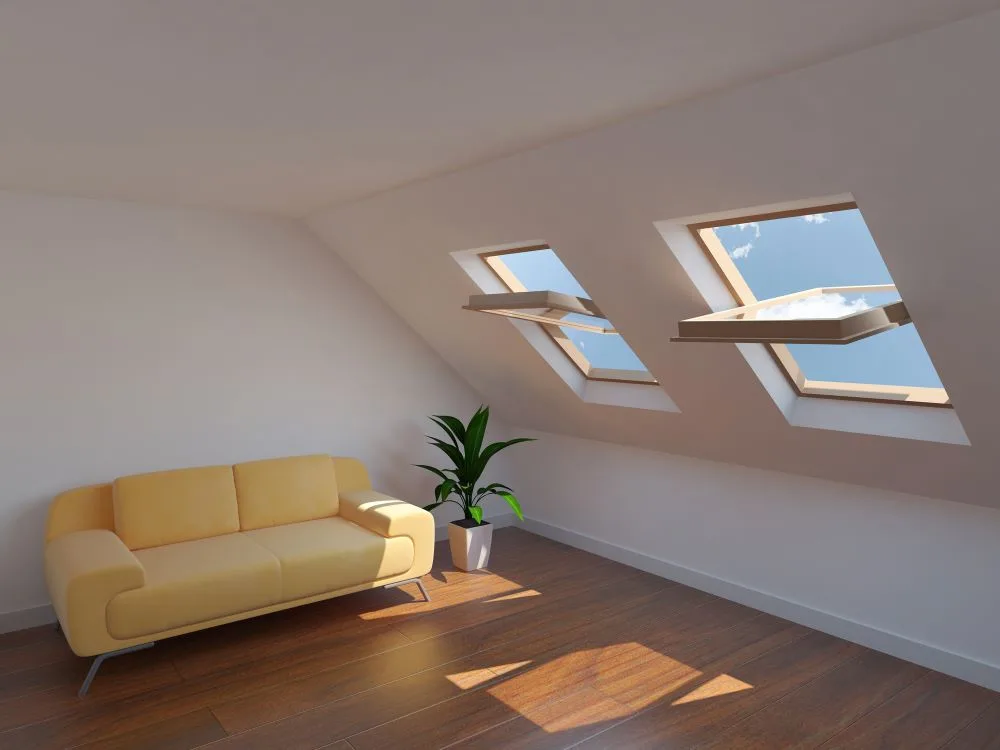
Pros
- Adds natural light as well as ventilation.
- Helps prevent mold and mildew.
- Light without extra power cost.
Cons
- Requires large enough roof for installation.
- Prone to leaking issues.
- Prone to condensation problems.
- Manual or remote-controlled opening and closing.
Average Cost and Installation
Installing a venting skylight can cost anything from $500-$3,000. Although, if you DIY the installation it might cost less. An electric skylight will cost more than a manual version.
It might be worthwhile to hire a professional to install a venting skylight as they are considered difficult to put in, and improper installation will result in leaking.
6. Mushroom Vent
Mushroom vents use passive and mechanical airflow due to the inclusion of a fan in the design. This fan helps move air through the ventilation system instead of relying on natural ventilation methods.
This makes them more reliable for ventilating the shed and will be less impacted by temperature and wind.
Pros
- Can be painted to blend with roof.
- Uses mechanical and passive ventilation.
- Wind-powered.
- Works on variety of roof styles.
Cons
- Bulky and unsightly.
- Relies on wind.
- Need to be in exposed location.
Average Cost and Installation
You can pay anywhere from $50-$300 for mushroom vents. Individual units range from $20-$100 each, so a DIY installation can end up being cheap.
Mushroom vents should be relatively easy to install if you have some experience in DIY home improvement. However, it does involve cutting into your roof and extensive sealing, so I recommend calling a reputable professional to install it if you are unsure.
7. Exhaust Fan
An exhaust fan moves air in and out of a room using reliable mechanical ventilation. This is especially helpful if you store a lot of chemical and organic compounds in the shed.
Exhaust fans can be electric or solar-powered and can be installed on a gable, wall, or roof vent (near the roof’s peak). You would likely only need one installed on a vent in the shed to help create more air movement that uses the rest of the passive vent more effectively.
Pros
- Reliable, consistent ventilation.
- Mechanically assists ventilation when installed on a vent.
- May include dehumidifier.
- Helps prevent mold and mildew.
- Can be automatic.
- Energy-efficient solar-powered option.
Cons
- High maintenance.
- A dehumidifier can dry out the shed.
- Requires electrical connection or solar panel.
- Components wear.
- Requires intake vents.
Average Cost and Installation
Installing an exhaust fan might cost you $200-$1,400, but you may need to factor in a higher cost for installing a solar panel and intake vents for effective ventilation.
It is a relatively simple task to install the exhaust fan onto a vent; however, I recommend calling a professional to install and sign off on the electrical side of the installation.
Ventilation Method Depends on Size, Design, and Use
Active vs Passive
Active ventilation uses fans to exhaust air from a room or building. This uses mechanical ventilation. Comparatively, passive ventilation uses natural ventilation methods, relying on thermal buoyancy and air currents.
Passive ventilation is important for small sheds (60 ft2 or less) as these are not big enough to have good natural airflow within the room, especially if it is full of stored items.
Larger sheds have more air that needs to move in and out, so active ventilation is the best option to ensure that the shed has fresh air.
Number of Ventilation Points
The size of your shed will also impact how many ventilation points there are and how many should or can be installed.
A smaller shed might need more ventilation points as there is less room for air to circulate inside. Larger sheds might also have a window or two.
You will need to use multiple points if you aren’t using an exhaust fan. For your ventilation to be effective, you will need vents at lower and higher points on the roof in order to create airflow in and out of the shed.
Location of Ventilation Points
Ventilation points need to be in the right place to be helpful. Where you place these points depends on which method or methods you are opting for. For example, soffit vents must be installed under the eaves and ridge vents must be installed at the roof’s peak, or they will not function properly.
In general, these ventilation points need to be on the roof, whether at the top, under the eaves, or on the side panels. They need to be high enough to employ thermal buoyancy.
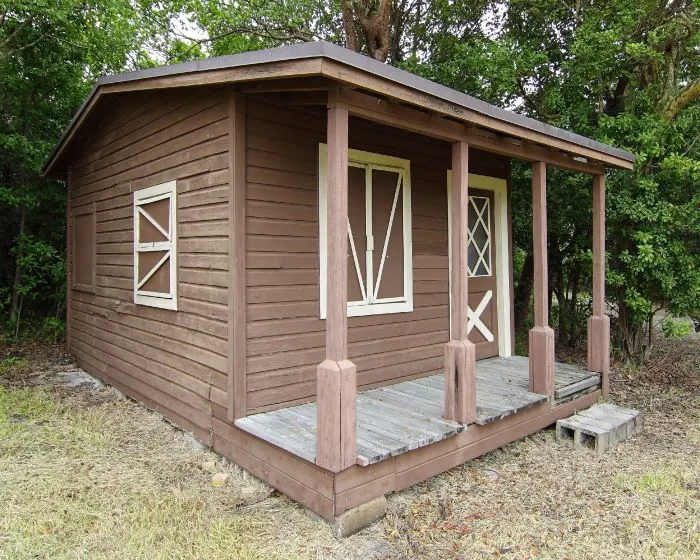
Why Ventilate a Shed?
Venting Bad Odors
I don’t know about you, but compost doesn’t smell the best, and some types are even worse than others!
If you use the shed for gardening, workshopping, or storage, ventilating it will help to aerate the room, keep any unpleasant odors at bay, and prevent the shed from becoming musty.
Mold and Mildew Prevention
Good airflow helps to inhibit mold and mildew growth by allowing the shed to cool in the heat of summer and to get rid of any moisture building up.
Toxic Gases
Gardening and other supplies are often kept in sheds and need ventilation to prevent the build-up of gases that can pose a risk to you.
Chemical fumes can make you sick by spending time in the shed. Ventilation will prevent these fumes from becoming dangerous if you store paints, fuel, or compost in the shed.
Compost can host many fungi and pathogens and must be handled with care to prevent serious health risks. Part of this involves storage conditions. The compost (and other soils and soil supplements) should be stored to allow for airflow and keep excess moisture away from the materials.
Decrease Risk of Fire
Compost and stored chemicals that do not have proper ventilation and airflow are a combustion risk. An insulated shed will inhibit airflow further.
Compost fires are rare, but the conditions that would cause them to combust can likely be found in an unventilated and insulated shed. To prevent fires, Nachi recommends adequate ventilation to manage the temperature of the pile and to not let the pile get too dry.
Your Workspace
Sheds usually don’t require ventilation because they are not habitable. However, they are frequently utilized as office space for various purposes. Ventilation is necessary for sufficient airflow, air quality, and oxygen supply to make the space into a habitable space.
Venting a Play Space
An insulated shed that is protected from much of the outside temperatures would make a great playroom for the kids. Of course, the same requirements for airflow, air quality, and oxygen supply apply to the room where your children, their friends, or any pets might spend hours in.
Sources
https://shedsunlimited.net/blog/17-storage-shed-uses-101-examples/
https://www.shedliquidators.com/blog/2014/properly-ventilate-shed/
https://www.tigersheds.com/blog/how-to-ventilate-your-shed-or-log-cabin/
https://finalcutroofing.com/the-benefits-of-soffit-vents/
https://homeguide.com/costs/cost-to-install-roof-vent
https://www.cupolasnmore.com/what-is-a-cupola/
https://www.ezpzroofing.com/ventilation/gable-vent/
https://www.angi.com/articles/ridge-vent-cost.htm
https://www.genesisroofingiowa.com/blog/roofing/venting-vs-fixed-skylights-pros-and-cons/
https://www.roofmaster.net/pros-cons-different-types-roof-vents/
https://www.houselogic.com/remodel/windows-doors-and-floors/skylight-installation-costs-tips/
https://roofstores.co.uk/how-to-install-soffit
https://www.iko.com/na/pro/building-professional-tools/roofing-101/how-to-install-a-roof-vent/



